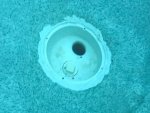- Mar 10, 2013
- 82
Update:
With a 11 hour bucket test:
Pump on: 1/4" lost in pool, bucket lost 1/16"
Pump off: 1/4" lost in pool, bucket lost 1/16"
From what I read, this leads me to believe it's a shell or fitting issue, not plumbing or pump/filter equipment. It would also confirm why the leak detector found the pressure hold steady in his pressure test of the skimmer and main drain returns. I already had the upper tiles all re-grouted, step crack filled with cement, and skimmer area reinforced with cement to make sure no gaps. All return lines were puttied as well as light and main drain area. I do not see any other visible cracks in my diamondbright.
Any suggestions?
With a 11 hour bucket test:
Pump on: 1/4" lost in pool, bucket lost 1/16"
Pump off: 1/4" lost in pool, bucket lost 1/16"
From what I read, this leads me to believe it's a shell or fitting issue, not plumbing or pump/filter equipment. It would also confirm why the leak detector found the pressure hold steady in his pressure test of the skimmer and main drain returns. I already had the upper tiles all re-grouted, step crack filled with cement, and skimmer area reinforced with cement to make sure no gaps. All return lines were puttied as well as light and main drain area. I do not see any other visible cracks in my diamondbright.
Any suggestions?


